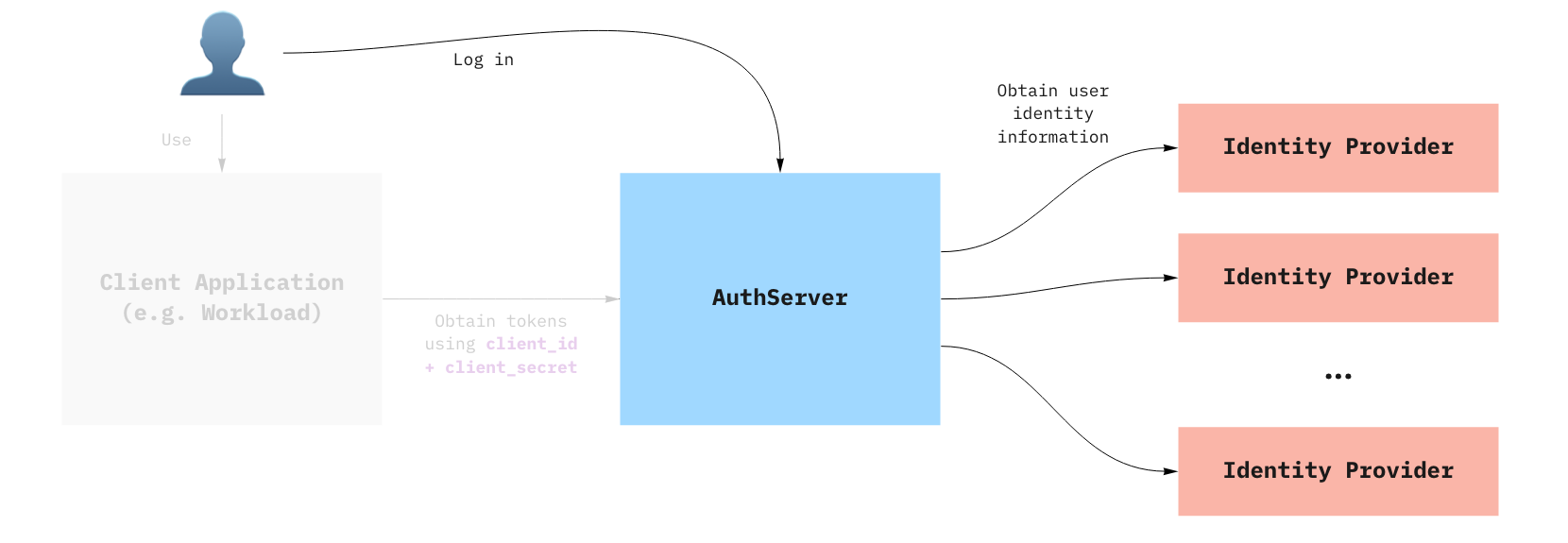Provision an AuthServer
This topic tells you how to provision an AuthServer for Application Single Sign-On (commonly called AppSSO). Use this topic to learn how to:
- Set up your first authorization server in the
defaultnamespace. - Ensure it is running so that users can log in.

Prerequisites
You must install AppSSO on your Tanzu Application Platform cluster and ensure that your Tanzu Application Platform installation is correctly configured.
AppSSO is installed with the run, iterate, and full profiles, no extra steps required.
To verify AppSSO is installed on your cluster, run:
tanzu package installed list -A | grep "sso.apps.tanzu.vmware.com"
For more information about the AppSSO installation, see Install AppSSO.
Provision an AuthServer
Deploy your first Authorization Server along with an RSAKey key for signing tokens.
CautionThis
AuthServerexample uses an unsafe testing-only identity provider. Never use it in production environments. For more information about identity providers, see Identity providers.
---
apiVersion: sso.apps.tanzu.vmware.com/v1alpha1
kind: AuthServer
metadata:
name: my-authserver-example
namespace: default
labels:
name: my-first-auth-server
env: tutorial
annotations:
sso.apps.tanzu.vmware.com/allow-client-namespaces: "default"
sso.apps.tanzu.vmware.com/allow-unsafe-issuer-uri: ""
sso.apps.tanzu.vmware.com/allow-unsafe-identity-provider: ""
spec:
replicas: 1
tls:
deactivated: true
identityProviders:
- name: "internal"
internalUnsafe:
users:
- username: "user"
password: "password"
email: "[email protected]"
emailVerified: true
roles:
- "user"
tokenSignature:
signAndVerifyKeyRef:
name: "authserver-signing-key"
---
apiVersion: secretgen.k14s.io/v1alpha1
kind: RSAKey
metadata:
name: authserver-signing-key
namespace: default
spec:
secretTemplate:
type: Opaque
stringData:
key.pem: $(privateKey)
pub.pem: $(publicKey)
You can wait for the AuthServer to become ready with:
kubectl wait --for=condition=Ready authserver my-authserver-example
Alternatively, you can inspect your AuthServer like any other resource:
kubectl get authservers.sso.apps.tanzu.vmware.com --all-namespaces
and you should see:
NAMESPACE NAME REPLICAS ISSUER URI CLIENTS STATUS
default my-authserver-example 1 http://my-authserver-example.default.<your domain> 0 Ready
As you can see your AuthServer gets an issuer URI templated. This is its entrypoint. You can find an AuthServer’s issuer URI in its status:
kubectl get authservers.sso.apps.tanzu.vmware.com my-authserver-example -o jsonpath='{.status.issuerURI}'
Open your AuthServer’s issuer URI in your browser. You should see a login page. Log in using username = user and password = password.
You can review the standard OpenID information of your AuthServer by visiting http://my-authserver-example.default.<your domain>/.well-known/openid-configuration.
ImportantIf the issuer URIs domain is not yours, the AppSSO package installation must be updated. For more information, see Install Application Single Sign-On.
The AuthServer spec in detail
Here is a detailed explanation of the AuthServer you have applied in the above section. This is intended to give you an overview of the different configuration values that were passed in. It is not intended to describe all the ins-and-outs, but there are links to related docs in each section.
Feel free to skip ahead.
Metadata
metadata:
labels:
name: my-first-auth-server
env: tutorial
annotations:
sso.apps.tanzu.vmware.com/allow-client-namespaces: "default"
sso.apps.tanzu.vmware.com/allow-unsafe-issuer-uri: ""
sso.apps.tanzu.vmware.com/allow-unsafe-identity-provider: ""
The metadata.labels uniquely identify the AuthServer. They are used as selectors by ClientRegistrations, to declare from which authorization server a specific client obtains tokens from.
The sso.apps.tanzu.vmware.com/allow-client-namespaces annotation restricts the namespaces in which you can create ClientRegistrations targeting this authorization server. In this case, the authorization server only picks up client registrations in the default namespace.
The sso.apps.tanzu.vmware.com/allow-unsafe-... annotations enable “development mode” features, useful for testing. Those should not be used for production-grade authorization servers.
For more information about annotations and labels in AuthServer resource, see Annotation and labels.
TLS & issuer URI
spec:
tls:
deactivated: true
The tls field configures whether and how to obtain a certificate for an AuthServer to secure its issuer URI. If you deactivate tls, the issuer URI uses plain HTTP.
CautionPlain HTTP access is for development purposes only and must never be used in production. For more information about the production readiness with TLS, see Issuer URI & TLS.
Token Signature
---
apiVersion: sso.apps.tanzu.vmware.com/v1alpha1
kind: AuthServer
# ...
spec:
tokenSignature:
signAndVerifyKeyRef:
name: "authserver-signing-key"
---
apiVersion: secretgen.k14s.io/v1alpha1
kind: RSAKey
metadata:
name: authserver-signing-key
namespace: default
spec:
secretTemplate:
type: Opaque
stringData:
key.pem: $(privateKey)
pub.pem: $(publicKey)
The token signing key is the private RSA key used to sign ID Tokens, using JSON Web Signatures, and clients use the public key to verify the provenance and integrity of the ID tokens. The public keys used for validating messages are published as JSON Web Keys at {.status.issuerURI}/oauth2/jwks.
The spec.tokenSignature.signAndVerifyKeyRef.name references a secret containing PEM-encoded RSA keys, both key.pem and pub.pem. In this specific example, we are using Secretgen-Controller, a TAP dependency, to generate the key for us.
Learn more about Token Signatures.
Identity providers
spec:
identityProviders:
- name: "internal"
internalUnsafe:
users:
- username: "user"
password: "password"
email: "[email protected]"
roles:
- "user"
AppSSO’s authorization server delegates login and user management to external identity providers (IDP), such as Google, Azure Active Directory, Okta and so on. See diagram at the top of this topic for more information.
In this example, we use an internalUnsafe identity provider. As the name implies, it is not an external IDP, but rather a list of hardcoded user/passwords. As the name also implies, this is not considered safe for production. Here, we declared a user with username = user, and password = password. For production setups, consider using OpenID Connect IDPs instead.
The email and roles fields are optional for internal users. However, they will be useful when we want to use SSO with a client application later in this guide.
CautionVMware discourages using the
internalUnsafeidentity provider in production environments.
Configuring storage
An AuthServer issues a Redis instance by default. It can be used for testing, prototyping and other non-production purposes. No additional configuration is required.
To configure your own storage that is ready for production, see Storage.